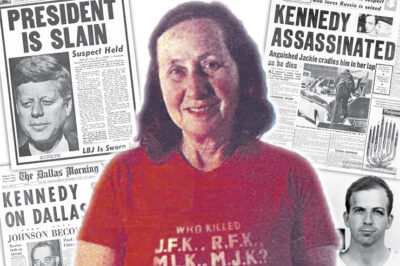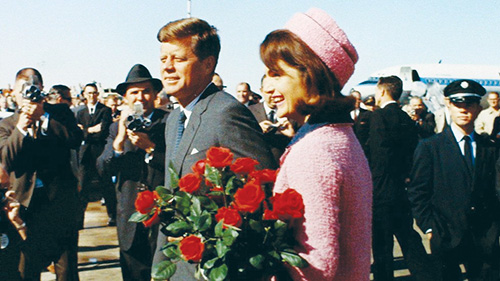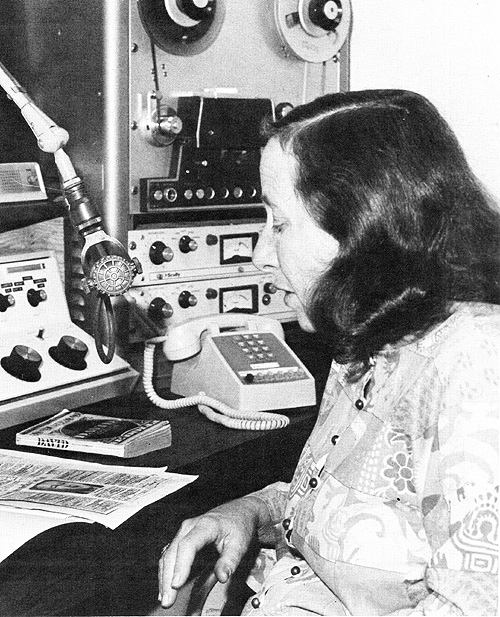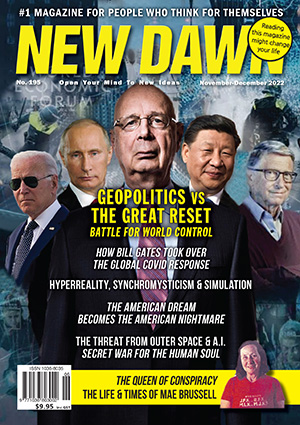From New Dawn 195 (Nov-Dec 2022)
Conspiracy – a planning or acting together secretly, usually for a harmful purpose.
– Webster’s New World Dictionary
You can only solve a murder by knowing who’s destroying the evidence.
– Mae Brussell
22 November 1963. The shot heard around the world. A beloved president dead. A nation crippled with grief. But for one Beverly Hills housewife and mother of five, it was a day that would become the catalyst for a mind-boggling journey into the shadowy world of lies, deception, cover-ups, conspiracy and murder.
For Mae Magnin, daughter of prominent Wilshire Boulevard Temple Rabbi Edgar Magnin and great-granddaughter of Isaac Magnin, founder of the I. Magnin department stores, the world BKA (Before Kennedy Assassination) consisted of tennis lessons, dance classes, and famous house visitors that included Louis B. Meyer, Jack Warner and Albert Einstein.
A child raised in Beverly Hills affluence, Mae and her family lived well, vacationed often, and were untouched by the Depression. But Mae was different, expressing her empathy for the underprivileged from an early age. A trip to Bombay and Singapore during her teen years exposed her to the overwhelming poverty of the third world.
“I was haunted by the imbalance. I wanted to help people, but I didn’t know what form it would take,” Mae told Paul Krassner of High Times magazine. She attended Stanford University, majoring in philosophy. She had no real goal in life – until the shot heard around the world. Kennedy’s death haunted Mae and, like many others, she didn’t buy the theory that Lee Harvey Oswald was the lone gunman. When Jack Ruby killed Oswald live on television, Mae’s destiny was set in stone.
When Lee Harvey Oswald was instantly fingered as the lone assassin, something didn’t sit right in Mae’s gut. She was a woman, and women, especially mothers, seemed to know that things on the surface often shielded a deeper, darker truth. But with tennis lessons and dinners with friends taking up her social calendar, Mae had never given her intuition and instinct too much thought or energy.
Until now.
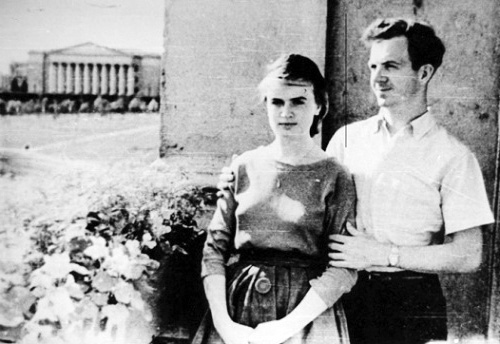
The death of Kennedy shocked her just as it did the entire nation, indeed, the world. But it was another event that would transform this wealthy and privileged housewife and mother living the good and easy life into a fierce and fearless crusader for truth and the verifiable title of “Queen of Conspiracy.”
The single incident that launched Mae headlong into the world of conspiracy theory was the murder of Lee Harvey Oswald.
Mae had been married twice. Her first marriage resulted in two sons, and her second marriage to Bill Brussell, when she became Mae Brussell, resulted in three daughters. Shortly before Oswald’s death, Mae’s seven-year-old daughter Bonnie had seen Oswald on TV and said she felt sorry for him. Oswald pled his innocence to the national media, sporting a black eye that he had no doubt incurred from police brutality. Bonnie asked her mom if they could send Oswald her favourite teddy bear. Together, Mae and Bonnie wrapped up the bear and packaged it to send to Oswald. But the bear never got shipped.
That Sunday Morning, live on national television, a mysterious man named Jack Ruby killed Oswald. Mae watched in abject horror. She knew something was terribly wrong, and that the American people were being lied to.
“Why did they let Ruby in (to the jail) when everyone knew who he was and that he had recently been charged with possession of illegal weapons?” Mae had asked herself, according to a 1971 interview in The Carmel Pine Cone. “Had he been hired to kill Oswald?”

Mae’s instinct for questioning authority kicked into high gear and she became obsessed with finding out what was going on behind the veneer of the official announcement that Oswald was the lone killer, and that Ruby had been some great patriot seeking revenge for his beloved country and out to prove that “even a Jew could be a hero,” as he himself had so succinctly put it. She began to worry about what kind of world her children might inherit if these kinds of cover-ups and crimes could occur. That simple question – “What kind of world are we bringing our children into?” served as Mae’s mantra as she began what would become a lifelong quest for truth.
When Mae realised all was amiss, she did what any loving mother would do, if that loving mother happened to be Mae Brussell. She began clipping out any and every newspaper and magazine article she could find on the Kennedy assassination and ongoing investigation. Carefully cross-referencing and indexing her clippings, she launched what would eventually become a massive collection of hundreds of bulging file cabinets and boxes filled with papers and notebooks and documents related to the death of JFK and related conspiracies.
“My concern over who killed John Kennedy was basically selfish,” Mae would tell a journalist. She was doing it for her children, “to find out if there had been a coup – was the United States going fascist?”
As she delved into the Kennedy mystery, one clue led to another, and Mae found herself deep inside a cryptic, shadowy world of people and events connected to one another like the tentacles of an invisible octopus. All evidence on the outside was pointing to the CIA and anti-Castro Cuban exiles, but Mae’s research was disproving that theory daily. In fact, her research was leading her down a dark road that would threaten to destroy everything she as an American held dear.
Mae knew that if she had any chance at all of learning the truth, she had to see exactly what the authorities were concluding. Knowing how important this issue had become to Mae and that she was not the kind of woman to swoon over diamonds or a fur coat, her loving and understanding husband, Bill, decided to present Mae with the perfect Christmas gift – the 26-volume Warren Commission Report that detailed the official investigation of the Kennedy assassination.
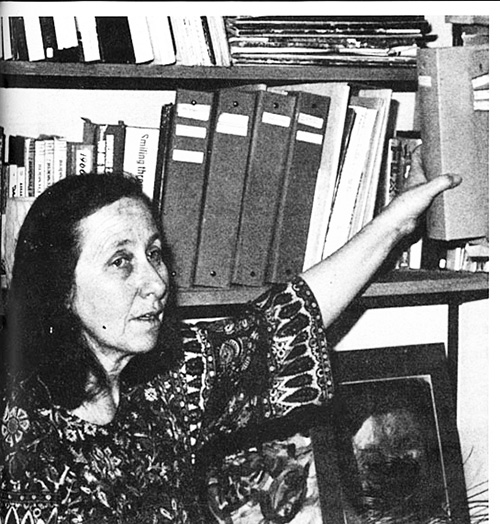
She became a woman haunted… a woman driven.
“I turned immediately to accounts in the Warren Commission Report of Oswald’s finances and friends – accounts that traced his career from the Marine Corps to Russia and back – his mobility.” Mae’s goal was to focus on Oswald, the patsy, as the entry point to a conspiracy that would at once draw her deeper, yet overwhelm her with its sinister implications.
She poured over the Commission report and the growing files of clippings she gleaned from the eight newspapers she now subscribed to, and other publications she tracked down like a bloodhound. Soon, she was finding links between Oswald, his wife Marina, and a group of wealthy and powerful financiers who literally funded Oswald’s activities. “These were oil people, engineers and security agents,” Mae stated. “It made me wonder…”
Mae spent two years studying the mass of material described in the Commission report, which included the testimonies of over 552 witnesses as well as ten separate volumes of hard facts accumulated by the Commission before the assassination. Among those files were Oswald’s personnel papers from the Marine Corps, the FBI and the State Department.
Although Mae would literally dissect Oswald and his entire life history, she would find that the Commission report was more than lacking. “I found that witness testimony given under oath didn’t match the evidence in the last 10 volumes, and that the Warren Commission Report quoted as factual witness testimony that they never heard because the Commission members were not present at the hearings and didn’t cross-examine witnesses. No two men ever heard the same thing,” Mae insisted.
These obvious discrepancies fuelled Mae’s conviction and she dug in deeper, noticing oddities throughout her research that others seemed to ignore. Her razor-sharp mind honed in on misquoted witnesses, times and dates that didn’t line up with the “official” explanations, and what she would come to call a “pattern and a rhythm to the questions and a cut-off point beyond which the Commission didn’t go…” But there was just so much material to tackle and so many confusing and conflicting testimonies to tear apart. Mae had to keep her focus if she was going to make any headway on this massive web of misinformation, deception and outright lies.
Oswald, the CIA & Fascists
Oswald was the key – she knew in her gut. Her research eventually led her to some intriguing conclusions involving a small group of people surrounding Oswald who appeared in Dallas just before the assassination and exited shortly afterwards. Many worked in the defence, oil and warfare industries. Who were these mysterious people, with so much access to power, and why were they so interested in a man like Oswald, who never seemed to hold the same job or stay in the same place for long? This was a man, Mae pondered, who had a continuous succession of jobs. He was never unemployed, but he had jobs selected for him.
Mae learned that these mysterious people surrounding Oswald were White Russian fascists,* and that they were part of a bigger network of underground fascists with America as their new stomping ground.
* The 1917 Bolshevik Revolution in Russia led to the exodus of the refugees known as White Russians or white émigrés. Elements of these exiled émigrés later became known as “White Russian fascists” whose aim was the overthrow of the Soviet Communists. Due to Marina Oswald’s background as “White Russian aristocracy” and her links to the CIA, Mae Brussell believed the “White Russian fascists” in the US were connected to JFK’s assassination.
She began corresponding with such Kennedy assassination luminaries as New Orleans District Attorney Jim Garrison (portrayed by Kevin Costner in the movie, JFK) and the mysterious Pentagon big-wig Col. Fletcher Prouty, whose own research was turning up a can of worms, and whose CIA connections made him prime fodder for Mae’s tools of dissection.
But Mae never bought the claims of CIA-backed anti-Castro Cuban involvement and while other researchers and even the authorities were busy focusing on the CIA, Mafia and anti-Castro Cuban connections, Mae’s instinct told her they were wrong.
JFK’s Assassination: An Obsession
While she threw herself deeper into the fray, Mae continued to take care of her five growing children, scuttling off from dance classes to doctors and orthodontists, then off to some school or social event. However, her friendships began to suffer, for Mae was no longer content to sit around sipping expensive teas and talking about the Southern California weather. She had new ideas thundering through her brain, ideas that she dared share with those willing to listen.
The problem was most, if not all, of Mae’s friends were simply not willing to listen. Mae’s obsession with the Kennedy assassination was not appropriate fodder for Beverly Hills social talk. Until then, as she told reporter Jill Wolfson in 1982, the extent of her political knowledge had been just enough to get her through a cocktail party. She began to feel more and more isolated in her newfound world of conspiracies, cover-ups and crimes. Eventually, her research would become her best friend, and her social life would diminish to caring for her family and running essential errands.
Tim Canale, an archivist and researcher who runs Maebrussell.com, Mae’s official website, recalls speaking with Mae’s best friend, Terre, who told him that “going to Mae’s house meant sitting in the living room filled with several huge barrels, each marked with different conspiracy-related topics. We all had to sit and clip newspaper and magazine articles and put them in the appropriate barrels.”
Terre recalled taking Mae to see a re-release of the original film Manchurian Candidate starring Frank Sinatra. During one scene in the movie, Mae took out a notebook and pen and wrote down the names of the books that were on the movie set bookshelves in the background. According to Terre, Mae thought some of the books might be important to her research. This is what it was like to hang out with Mae aka, After Kennedy Assassination.
Mae tried to explain her position in a Playgirl Magazine interview in 1974. “People sometimes wonder how an ordinary housewife like me could get so interested in the John F. Kennedy assassination. But nothing just happens. There has to be a time when you begin to think and feel an emotional climate of caring about people, a nurturing place where you give a damn… That’s where my head was when Kennedy was assassinated. I was worried about my children and what sort of society we were living in where this murder could take place.”
Mae’s obsession would eventually cost her two marriages, including her 17-year marriage to Bill Brussell, the father of her three daughters. But for now, it was not an issue. She was keeping her kids happy and her family intact. Attending cocktail parties and afternoon soirees was just not on her agenda.
She had more important things to do.
Uncovering Deeper Layers
As Mae followed the dotted line between Kennedy’s death, the enigmatic Oswald, the mysterious Jack Ruby, the Warren Commission Report’s sins of omission and error, and her own ever-increasing files of clippings, she watched apprehensively as the tentacles of this one simple conspiracy reached out into directions that even her brilliant, detail-oriented mind could not grasp.
She understood that the Kennedy assassination was a sort of foundational cornerstone that led to many other conspiracies waiting to be uncovered, including the subsequent assassinations of Bobby Kennedy and Martin Luther King, Jr., both of which Mae added to her list of subjects to tackle.
As suspected, she would find links between all three assassinations and the same key players involved in what seemed like an eerie theatre performance that repeated itself over and over, with only the times, locations and the extras changing.
The Warren Commission Report may have been Mae’s first real exposure to a bonafide government cover-up on paper. She had read the report inside and out, and there was little fact to back up the claims of the final summary of the Commission. She knew that the report failed to mention what her own research had uncovered – that Oswald was an intelligence agent used by his superiors.
“Oswald was expendable,” Mae told Playgirl in 1974, “he was a throw-away person… He was framed, defamed, and then murdered.” All Mae could think of was why? What were they all hiding? Who was behind the cover-up and what was the ulterior motive for killing a man so many people adored?
“The discrepancies between the evidence and what was written (in the Warren Report) are staggering,” Mae told Jill Wolfson in 1982. “And what was even more staggering was seeing how the assassination related to other worldly events.”
This intricate web of conspiracy would take up the rest of Mae’s life as she struggled to make sense of it all. She found several connections between the CIA and Germany of the 1920s and 1930s in her studies of the report, mainly via the people who surrounded the key players; witnesses and bit players and friends of the Oswalds, hangers-on who each had a role in the plot to kill Kennedy and who could be traced directly to White Russian fascists and old Germany.
But it wasn’t just the people that connected, it was the events before and after WWII that Mae found fit together like the pieces of a gigantic jigsaw puzzle.
“The murder of John Kennedy was not an isolated world assassination. It was a large plot where people were murdered before him and after him, up until the present date. The sole purpose is to remove any person from office or power who intends to have world peace.” This comment would ring true as peacemakers such as Bobby Kennedy, Martin Luther King, Jr., Anwar Sadat and even Mahatma Gandhi years earlier were downed from the guns of “lone fanatics.” Mae knew better. Nothing about these “lone fanatics” hinted at solitary motives and single-minded agendas. It was all connected.
Mae was so convinced of what she knew that on 29 May 1968 she went to the Monterey Peninsula Airport to meet Rose Kennedy and handed her a note telling her that Robert “Bobby” Kennedy would soon be assassinated. One week later, Bobby was shot and killed at the Ambassador Hotel in Los Angeles, California.
These were Mae’s beliefs after eleven years of research and study, enough, Mae laughed, to gain her the highest degree of any university, had they offered a PhD in conspiracy theory.
That large plot that Mae spoke of took on the form of a huge and ghastly octopus, with tentacles reaching into the highest halls of government, military and business institutions. One of the octopus tentacles Mae followed linked the Kennedy assassination to a very unexpected and utterly terrifying source. Nazis.
Paperclip Nazis
As Mae looked deeper, accumulated more, and questioned further, she came face to face with an underground network of Nazis holding great positions of power and influence in the United States, land of democracy and freedom. These Nazis, mainly scientists, military officials, engineers and weapons experts, had been secretly smuggled into the United States after World War II on full knowledge of the CIA, who actually had a hand in getting them safely to US shores.
Project Paperclip, also called Operation Paperclip, was a top-secret government program of integrating Nazi top dogs into American society, and thanks to the power of the Freedom of Information Act, the once classified program was now seeing the public light.
Mae’s research suddenly took a sharp turn to the right, the extreme right, as she realised that the international terrorist network that made up the Axis powers during WWII had effectively gone underground to continue their worldwide campaign of fascist rule even after Hitler was supposedly buried in Argentina (something else Mae contested). The names, tactics and methods the Nazis used in WWII were similar to those Mae recognised from her research into Germany in the 1920s and early 1930s, and now those tactics were being used here in modern-day America.
As a Jew with love for her people’s heritage, this struck Mae at her very core. Were these Nazis, she wondered, here in America just to become wealthy and successful? Or was there something far more sinister afoot? This would become Mae’s central obsession, her life’s mission, her ultimate quest for truth: to prove that the Nazis were grooming political figures to assist them in carrying out a second Holocaust – this time right here in the good old U.S. of A.
The list of countries that the Nazis had an underground hold was mind-boggling, countries where presidential coups and military actions had taken place surrounded by media blackouts, martial law and cries of conspiracy among the dead and dying.
Brazil, Argentina, Peru, El Salvador, the Philippines, Portugal, and Greece. And always, the United States. Mae took to describing the relationship between Kennedy’s death and the Nazis, along with help from the mob and the CIA, as “the Odd Couple Plus One.” She would continue to stumble across evidence of complicity between this triadic odd couple – Nazis, the Mafia and the CIA, again and again and again.
Mae was on her way to solidifying her place at the top of the heap of conspiracy theorists, although this title was offensive to Mae. Friends and followers called her a true political theorist and a brilliant researcher. Mae felt the term “conspiracy theorist” was beneath her. One writer would even label Mae “a modern Sherlock Holmes,” and another “the country’s self-proclaimed top conspiracy yenta, keeping tabs on political goings-on in much the same way that a gossip watches over the neighbourhood.” But Mae was not into gossip, just cold, hard facts, and she had plenty to go around.
The second part of this article, to be published in our next issue, covers Mae Brussell’s foray into a wider web of conspiracies exposed by her ongoing research and contacts.
Sources
“The Queen of Conspiracy: The Life and Times of Mae Brussell.” Marie D. Jones. Paranoia Magazine. Spring 2013.
“About Women…” Stephanie Caruana. Playgirl, August 1974.
“The Ballad of Mae Brussell.” Paul Krassner. High Times, September 1991.
“The Mind of Mae Brussell.” Paul Krassner. Oui, May 1978.
“Shots Fired! The Story of Mae Brussell, Queen of Conspiracy.”Marie D. Jones.www.amazon.com/Shots-Fired-Death-Dallas-Conspiracy-ebook/dp/B08RWXZ31M
“The World According to Mae.” Jill Wolfson. San Jose Mercury News, March 1982.
© New Dawn Magazine and the respective author.
For our reproduction notice, click here.

